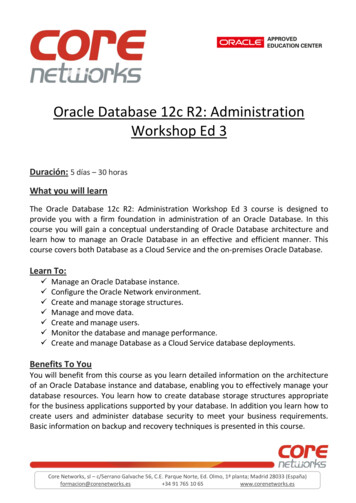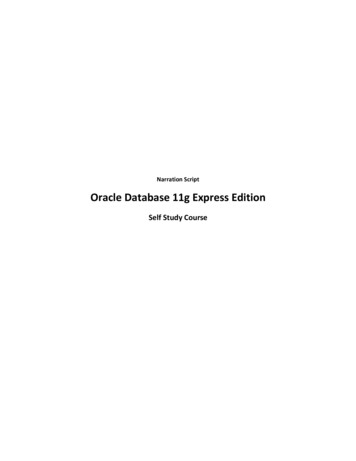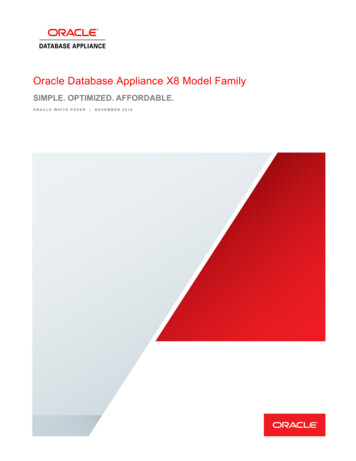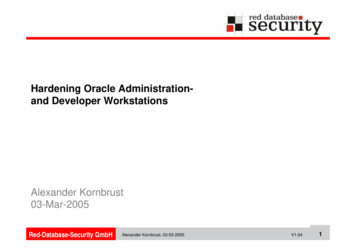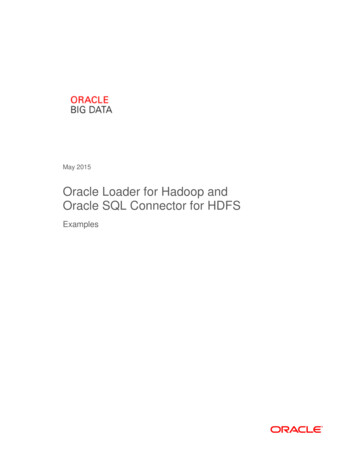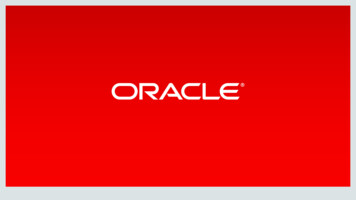
Transcription
Best Practices for Oracle DatabasePerformance on WindowsChristian ShayProduct ManagerOracle Database on WindowsOracle Q A Panel:Santanu Datta , Scott Jesse, Kant PatelRavi Thammaiah, Bryan VongrayCopyright 2015, Oracle and/or its affiliates. All rights reserved. Oracle Confidential – Internal/Restricted/Highly Restricted
Program Agenda1Overview2Architecture3Best Practices for Windows4Best Practices for RAC on Windows5Q A: Ask the ExpertsCopyright 2015, Oracle and/or its affiliates. All rights reserved.
Slide deck for this session Within a week, slides will be linked to on OTN Windows page:– http://otn.oracle.com/windows Should also be available from Openworld websiteCopyright 2015, Oracle and/or its affiliates. All rights reserved.
OverviewCopyright 2015, Oracle and/or its affiliates. All rights reserved.
Windows 8.1, Windows Server 2012 R2 and Windows 10 EditionsSupported Editions Windows 8.1 Editions– Pro and Enterprise Windows Server 2012 R2 Editions– Essentials, Foundation, Standard and Datacenter Windows 10 Editions– Pro, Enterprise and EducationCopyright 2015, Oracle and/or its affiliates. All rights reserved.
Windows 32-bit OS Platform SupportOS11gR2 #112cR1 client #2Windows 7YesYesWindows Server 2008YesYesWindows Server 2008 R2YesYesWindows 811.2.0.4YesWindows 8.111.2.0.412.1.0.2Windows Server 201211.2.0.4YesWindows 10No12.1.0.2 (Planned)Copyright 2015, Oracle and/or its affiliates. All rights reserved. #1RAC not supportedfor 32-bitWindows in 11gR2and later#2Only DB Client issupported for 32bit Windows in12cR1
Windows 64-bit (x64) OS Platform SupportOS11gR212cR1Windows 7 #1YesYesWindows Server 2008YesYesWindows Server 2008 R2YesYesWindows 8 #111.2.0.4YesWindows 8.1 #111.2.0.412.1.0.2Windows Server 201211.2.0.412.1.0.2Windows Server 2012 R211.2.0.412.1.0.2Windows 10 #1No12.1.0.2(Planned)#1RAC and some otherfeatures notsupported onWindows client OSWindows 32-bit version of Oracle Client is also supported on Windows x64 systemsCopyright 2015, Oracle and/or its affiliates. All rights reserved.
Hyper-V certificationMicrosoft Hyper-V Server 2012 and Hyper-V Server 2012 R2 are certified.Guest OS11gR212cR1Windows Server 2008 R211.2.0.4 (SingleInstance only)12.1.0.2 (SI only)Windows Server 201211.2.0.4 (SI andRAC)12.1.0.x (SI only)Windows Server 2012 R211.2.0.4 (SI andRAC)12.1.0.2 (SI andRAC)Copyright 2015, Oracle and/or its affiliates. All rights reserved.
ArchitectureCopyright 2015, Oracle and/or its affiliates. All rights reserved.
Database on Windows Architecture Thread model, not a straight port of Oracle’s process architecture 128 TB maximum memory per database instance Runs as a Windows service process No limits on memory, connections, resources except those imposed by theoperating systemCopyright 2015, Oracle and/or its affiliates. All rights reserved.
File I/O Supports asynchronous I/O to all types of files– Asynch IO support on Windows is very good for both file system and raw devices.– No need to set INIT.ORA parameter “filesystemio options”– Default value of “asynch” is the recommended setting Logical and physical raw files and partitions are fully supported– Faster than NTFSCopyright 2015, Oracle and/or its affiliates. All rights reserved.
Memory - Large Pages Large Page support– For instances with large memory requirements, large page support can improveperformance.– To enable, set registry parameter ORA LPENABLE– x64 – 4kb default page size – will now be 2 MB In 12c, if Oracle Home User is a standard Windows account, theadministrator must grant the "Lock pages in memory" privilege to OracleHome User or Service SID of Oracle Database Service(NTAUTHORITY\OracleService sid )Copyright 2015, Oracle and/or its affiliates. All rights reserved.
Memory - Large PagesMemory Fragmentation issues Windows Server may be slow to allocate a huge amount of memory whenusing large pages especially if memory is already fragmented. Start Oraclebefore other processes if this affects you. Oracle Database 12c introduces a new option to allow use of large pagesbut it will fall back to small pages if OS is not able to allocate large pagesCopyright 2015, Oracle and/or its affiliates. All rights reserved.
Memory - Large PagesNew in 12c: “Mixed Mode” Under HKEY LOCAL MACHINE\SOFTWARE\ORACLE\KEY HOMENAME– Create ORA LPENABLE or ORA SID LPENABLE– Set the value to 1 for regular mode and 2 for mixed mode– Mixed mode is a new 12c option to allow use of large pages but fall back to smallpages if OS is not able to allocate large pages– ORA SID LPMAXTIME is the optional time parameter for mixed modeCopyright 2015, Oracle and/or its affiliates. All rights reserved.
Memory - NUMANon Uniform Memory Access NUMA support for memory/scheduling Database intelligently allocates memory and schedules threads based onnode configuration Test well before going into production. Work with your hardware vendorand Oracle support to enable NUMA.Copyright 2015, Oracle and/or its affiliates. All rights reserved.
Hyperthreading Circuitry added to Intel CPUs resulting in single CPU functioning as 2 CPUs All versions of Oracle are supported in Hyperthreaded environments.Copyright 2015, Oracle and/or its affiliates. All rights reserved.
Direct NFS Client on Windows Network Attached Storage (NAS) uses Network File System (NFS) As of 11g, Oracle Database allows direct Windows NFS v3 access– NFS v4 is supported starting with 12.1 Part of DB kernel in Oracle Disk Manager libraryCopyright 2015, Oracle and/or its affiliates. All rights reserved.
Direct NFS Client on Windows Bypasses a lot of software layers in OS Tailored for the specific I/O patterns that Oracle usesCopyright 2015, Oracle and/or its affiliates. All rights reserved.
Direct NFS Client on Windows Linear scalability of direct NFS can be achieved with inexpensive NICS Does not require expensive switches which support link aggregation– Oracle does load balancing rather relying on a switch. Parallel network paths– More NICS – more bandwidth Direct NFS is a good solution from low to high end database serversCopyright 2015, Oracle and/or its affiliates. All rights reserved.
Direct NFS Client on Windowsdnfs batch size In Database 12c Release 1, dnfs batch size allows Windows systems thatdon't have enough bandwidth to throttle the number of IOs that can bequeued by an Oracle process, which may improve overall performance.– Start at 128 and increase or decrease it based on NFS server performance.Copyright 2015, Oracle and/or its affiliates. All rights reserved.
Best Practices for WindowsCopyright 2015, Oracle and/or its affiliates. All rights reserved.
Diagnostic Tools - Enterprise ManagerCopyright 2015, Oracle and/or its affiliates. All rights reserved.
Diagnostic Tools - Performance MonitorCopyright 2015, Oracle and/or its affiliates. All rights reserved.
Process ExplorerCopyright 2015, Oracle and/or its affiliates. All rights reserved.
OS Tools tasklist, taskkill tlist (Shows command line args with -c) driverquery diskpart sc (sc query state all) process monitor (regmon, filemon, procexp) tcpview Windows Services for Unix PowershellCopyright 2015, Oracle and/or its affiliates. All rights reserved.
Client Diagnosability OCI and Net tracing and logging uses ADR by default First Failure Capture– No need to reproduce a second time to get a dump Client and Server trace file correlation Reduce one-off diagnostic patches Structure Dump Facility– Dumps more than just a stack Client-Side Crash Handler– Generates error message & stack trace, and controls core dump locationCopyright 2015, Oracle and/or its affiliates. All rights reserved.
12c Auto-Tuning Automatically tune client-side OCI Statement Cache size Low value will cause more soft parses on server, and higher network and CPU gettingcursor meta-data to client repeatedly High value will cause more memory usage on client Auto tuning continuously monitors various parameters and adjusts sizeinternally to optimal performance given memory constraints specified Enable during deployment via oraaccess.xml– Out-of-the-box solution that can be used by all OCI applications to improveperformance– Frees OCI drivers and applications from custom implementationsCopyright 2015, Oracle and/or its affiliates. All rights reserved.
ODP.NET Integration with Performance Monitor Monitor ODP.NET Connection Pools Enable inHKEY LOCAL MACHINE\SOFTWARE\ORACLE\ODP.NET\Assembly Version\PerformanceCountersCopyright 2015, Oracle and/or its affiliates. All rights reserved.
ODP.NET Integration with Performance MonitorCounters include (among many): HardConnectsPerSecond HardDisconnectsPerSecond SoftConnectsPerSecond SoftDisconnectsPerSecond NumberOfActiveConnection NumberOfFreeConnectionsCopyright 2015, Oracle and/or its affiliates. All rights reserved.
CPU Tuning ORACLE AFFINITY registry value can be set to tell Oraclewhich threads to run on which processors (same setting for allinstances) ORACLE AFFINITY must be set if more than 64 CPUsCopyright 2015, Oracle and/or its affiliates. All rights reserved.
Support for Multiple Processor Groups Support a max of 10 processor groups with up to 64 CPUs in each group in12.1.0.2 (12.1.0.1 supports 4 processor groups) ORACLE AFFINITY enhanced to enable affinity of Oracle threads to CPUs inmultiple processor groups– processorgroup is an optional parameter designating (multiple) Windows CPU groupswhich enables Oracle to use more than 64 logical CPUs. By default, a process utilizesa single processor group with a max of 64 CPUs.– Documentation link: http://bit.ly/1WdbJWa (Oracle Database Platform Guide forMicrosoft Windows)Copyright 2015, Oracle and/or its affiliates. All rights reserved.
CPU Tuning Use Database Resource Manager to set CPU usage fordifferent classes of users– For example, one can configure the db to use 50% CPU for goldcustomers, 30% for silver and 20% for rest Thread priorities can be set in the registry using theORACLE PRIORITY variableCopyright 2015, Oracle and/or its affiliates. All rights reserved.
CPU Tuning – Diagnosing High CPU Process Explorer: drill down to threads Get thread id of high CPU thread and then query– SELECT a.spid, b.username FROM v process a, v session b WHEREa.addr b.paddr AND a.spid thread number Copyright 2015, Oracle and/or its affiliates. All rights reserved.
Networking Best Practices Attend/download slides for Openworld 2015 session:– Oracle Net Services 12c: Best Practices for Database Performance andScalability [CON8418]– Tuesday, Oct 27, 5:15 p.m. Moscone South—104– Kant Patel, Director of DevelopmentCopyright 2015, Oracle and/or its affiliates. All rights reserved.
Networking Best Practices Use one listener per system The default queue-size for Windows Server is 50 – increase to200 or 300 using QUEUESIZE parameter in LISTENER.ORA –prevents errors during login storms Listener Logon Storm Handler– Configurable on server side in LISTENER.ORA (RATE LIMIT maxconn/sec )– Use only if you have logon storm issuesCopyright 2015, Oracle and/or its affiliates. All rights reserved.
Networking Best Practices Increase “DEFAULT SDU SIZE” in SQLNET.ORA or “SDU” inTNSNAMES.ORA– Controls SQL*Net packet size (Session Data Unit)– Default SDU size in 11g, 12c is 8k. For bulk data transfer scenarios,increase DEFAULT SDU SIZE in sqlnet.ora or SDU in tnsnames.ora. It canbe increased up to 2 MB in 12.1, 64K as of 11.2.0.2 and 32k for earlierversions.Copyright 2015, Oracle and/or its affiliates. All rights reserved.
Networking Best Practices– Any mix of 12c, 11g/10g will cause it to negotiate down to lower of thetwo peers (pre-11g default is 2K) For 10g increase DEFAULT SDU SIZE to 8k or higher.– Common misperception: Do not set to match MTU!Copyright 2015, Oracle and/or its affiliates. All rights reserved.
Networking Best Practices:Connection Timeouts Client Side connection timeouts: Achieve fast failover whenyou have multiple addresses in connect string– TCP.CONNECT TIMEOUT – as of 11g – Constrains only time required togo from client to listener (no db processing). It can be a few seconds.(60 Seconds default in 11.2). Tune down from there. Too low – falsepositives– SQLNET.OUTBOUND CONNECT TIMEOUT – Constrains time required togo from client to database (including db processing) - from 10gR2 andlater. Not set by default.– These two timeouts can be used individually or at the same timeCopyright 2015, Oracle and/or its affiliates. All rights reserved.
Networking Best Practices:Connection Timeouts Server Side connection timeouts:– SQLNET.INBOUND CONNECT TIMEOUT – available in 10gR1 and later default 60 secs for 10gR2 and later, not enabled by default for 10gR1;this can also be used along with the client side timeouts mentioned onthe last slide.Copyright 2015, Oracle and/or its affiliates. All rights reserved.
Networking Best Practices SQLNET.AUTHENTICATION SERVICES (NTS)– This is a default value in SQLNET.ORA, needed for OS authentication(connect / as SYSDBA)– It should be left at default on server side. Use SecureFile LOBs– NET stack optimizations provide very high throughput limited only bythe underlying hardwareCopyright 2015, Oracle and/or its affiliates. All rights reserved.
File System Best Practices - ASM Use Oracle Automatic Storage Management (ASM) – whethersingle-instance or RAC – use most recent version Benefits– Don’t need to move datafiles around– Don’t need to take tablespaces offline– Add disks with no downtime If you don’t use ASM, but want to use raw devices:– Use volume mount points to mount raw devices onto directories– Use this mount point as the file name for raw devices.Copyright 2015, Oracle and/or its affiliates. All rights reserved.
File System Best Practices - ASM ASM provides equivalent performance to RAW– Database instance directly accesses data on disks– ASM not in path between instance and storage Sun ASM vs RAW benchmark– ASM supported 80% more throughput with 50% shorter response CERN testing on 11.2: “ACFS much faster than ext3 with comparable orless CPU usage”Copyright 2015, Oracle and/or its affiliates. All rights reserved.
Stores All DataASM Cluster File System (ACFS) General purpose scalable filesystemSOAIMDBOC4JAPACHEDWODSPSFTEBSASM Cluster File SystemSiebelWeb Accessible through NAS protocols(NFS, CIFS)FileSystemBinariesOCR &Voting FilesDBDatafiles Multi OS platform (Linuxand Windows at initial release) Dynamic Volume ManagementSupported Read Only SnapshotsSupportedCopyright 2015, Oracle and/or its affiliates. All rights reserved.
File System Best Practices - OPatch – File lock issues Opatch warns to stop all Oracle process and services– Mandatory to bring down all oracle processes for the Oracle Home Opatch renames OCI.DLL to prevent locking issues by runningapplications MSDTC and other Windows OS processes only lock OCI.dll– WMI scripts running in WMISERVER.EXE could lock anything Look for third party software locking files/directories otherthan OCI.DLL and causing the problem– Find them, stop them (possibly stop WMISERVER too), and retry OPatchCopyright 2015, Oracle and/or its affiliates. All rights reserved.
Memory - Best Practices If system has more than 4G of SGA use sga target (and notmemory target). Use Large Pages: Having a fixed, non-pageable SGA with largepages (compared to dynamically growing SGA) has manybenefits, in particular, stability.Copyright 2015, Oracle and/or its affiliates. All rights reserved.
Using ORASTACK Each thread within Oracle process is provided 3.5 MB reservedstack space When needed use orastack to increase stack size:C:\ orastack oracle.exe 8000000 Some Oracle apps installations have required Oracle.exestacks as large as 32mbCopyright 2015, Oracle and/or its affiliates. All rights reserved.
Using ORASTACK Stop processes before running Orastack If you apply a patch, you must re-run OrastackCopyright 2015, Oracle and/or its affiliates. All rights reserved.
Migration from 32-bit Windows 32-bit to 64-bit upgrade process is simple– 32-bit data files are compatible with 64-bit DB– Only recreate control file if neccesary (eg file location changes) No need to recreate the database Full export and import not required Database Upgrade Assistant automates process Transparent migration for end-user applications– No changes required to existing client applications when running against 64-bitdatabaseCopyright 2015, Oracle and/or its affiliates. All rights reserved.
Best Practices for RAC on WindowsCopyright 2015, Oracle and/or its affiliates. All rights reserved.
Real Applications Clusters Use RAC for scalability and High Availability– Add instances against same database files providing more Oracleprocesses and increasing number of users– Provides unique scalability on Windows that no other vendoroffers Clustered databases supported on Windows platforms sinceversion 7.3.4Copyright 2015, Oracle and/or its affiliates. All rights reserved.
Real Applications Clusters Oracle provides platform independent Oracle Clusterware tohandle failover of services to surviving nodes Uses Oracle’s own clustering software, it does not depend onMSCSCopyright 2015, Oracle and/or its affiliates. All rights reserved.
RAC Best Practices for Performance Read “RAC and Oracle Clusterware Best Practices and StarterKit (Windows) (Doc ID 811271.1)” Installation and performance best practices Also contains excellent attached illustrated installationwalkthrough.Copyright 2015, Oracle and/or its affiliates. All rights reserved.
Anti-Virus Disable Anti-Virus software running on cluster nodes duringinstallation of Oracle on Windows (be mindful of manualreboots during this time). After install, the following should be excluded from beingscanned:– Oracle Software directories– OCFS filesystems– ACFS filesystems– Network scanning of the private interconnectCopyright 2015, Oracle and/or its affiliates. All rights reserved.
Anti-Virus Symptoms Some examples of how AV issues can manifest:– Installation freezing– Voting File Disk being locked– Node eviction issuesCopyright 2015, Oracle and/or its affiliates. All rights reserved.
/USEPMTIMER Set /USEPMTIMER in the boot.ini to prevent excessive LMDand LMS trace generation and to prevent connectivity issuesas described in Document 437101.1.Copyright 2015, Oracle and/or its affiliates. All rights reserved.
Non-Interactive Desktop Heap Size Increase size of the default Non-Interactive Desktop Heap to2MB to prevent instability due to Desktop Heapexhaustion. See Document 2056225.1 and KB947246. Consult with Microsoft for further tuning of the NonInteractive Desktop Heap beyond 2MB.Copyright 2015, Oracle and/or its affiliates. All rights reserved.
Generate .BLG files Run Perfmon to monitor CPU, Memory, Network, Disk IORates - To aid in troubleshooting, configure Perfmon tomonitor these OS statistics and to generate binary log files(.BLG). Instructions for implementing this change can be foundon the Microsoft support website using the following link:http://support.microsoft.com/kb/146005 Expensive – don’t run all the timeCopyright 2015, Oracle and/or its affiliates. All rights reserved.
Memory Allocation Keep memory allocation under 80%. Shoot for 75% allocated (eg more than 20-25% free) This will allow for ample memory needed for Windows OSoperations (including collection of physical memory dumps ifrequired).Copyright 2015, Oracle and/or its affiliates. All rights reserved.
Scalable Networking Pack Turn off default Scalable Networking Pack (SNP) features. On acomputer that has a TCP/IP Offload-enabled network adapter,you may experience many network-related problems likenetwork adapters consuming lots of nonpaged pool memoryor adapters requesting large blocks of contiguous memory -causing interference with internode communication. See Document 988008.1 and KB Articles KB948496 andKB951037 for instructions on how to fix.Copyright 2015, Oracle and/or its affiliates. All rights reserved.
ORAchk Health check tool Proactively scans for the most impactful problems across thevarious layers of your stack Supports Windows 2008 and 2012 Requires Cygwin to be installed.Copyright 2015, Oracle and/or its affiliates. All rights reserved.
Upcoming Windows Sessions and Demogrounds What’s New with Oracle Database 12c on Windows: On Premises andin the Cloud– Wednesday - 1:45 PM - 2:30 PM Moscone South – 308 Visit Windows experts at the Demogrounds:Oracle Database 12c on Windows– Today through Wednesday– Moscone South Exhibition Hall, Far Left Middle in Oracle Database Demogrounds– Booth SLD-003Copyright 2015, Oracle and/or its affiliates. All rights reserved.
Additional Oracle on Windows istian.shay@oracle.comCopyright 2015, Oracle and/or its affiliates. All rights reserved.
Questions and Answers: Ask the ExpertsCopyright 2015, Oracle and/or its affiliates. All rights reserved.
Safe Harbor StatementThe preceding is intended to outline our general product direction. It is intended forinformation purposes only, and may not be incorporated into any contract. It is not acommitment to deliver any material, code, or functionality, and should not be relied uponin making purchasing decisions. The development, release, and timing of any features orfunctionality described for Oracle’s products remains at the sole discretion of Oracle.Copyright 2015, Oracle and/or its affiliates. All rights reserved. Oracle Confidential – Internal/Restricted/Highly Restricted71
Copyright 2015, Oracle and/or its affiliates. All rights reserved. Oracle Confidential – Internal/Restricted/Highly Restricted72
Keep Learning with Oracle UniversityClassroom TrainingCloudLearning SubscriptionTechnologyLive Virtual ClassApplicationsTraining On DemandIndustrieseducation.oracle.comCopyright 2015, Oracle and/or its affiliates. All rights reserved. Oracle Confidential – Internal73
The default queue-size for Windows Server is 50 – increase to 200 or 300 using QUEUESIZE parameter in LISTENER.ORA – prevents errors during login storms Listener Logon Storm Handler –Configurable on server side in LISTENER.ORA (RATE_LIMIT m



